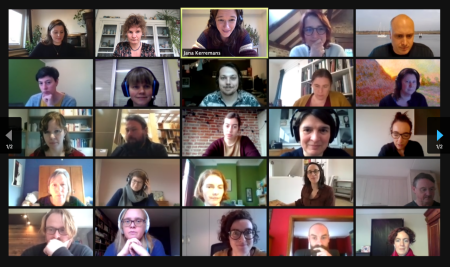Plans for the future: ICH included
What should you do with movable and intangible cultural heritage? The current Cultural Heritage Act promotes an integrated heritage approach to accommodate these two different aspects, but the main challenge is that they both operate according to a different set of rules. So how can you give intangible cultural heritage a place in your collection policy or plan? The organisation Werkplaats Immaterieel Erfgoed (WIE - ‘Workspace for Intangible Heritage’) investigated this question, together with partners, in their project ‘Plans for the future: ICH included’.
We use the term intangible heritage to refer to intangible cultural heritage on the rest of this page.
Challenge
Understanding and including intangible heritage
The Cultural Heritage Act 2017 enables an integrated approach to heritage, but this isn’t as simple as it might seem in practice – because heritage management is different for movable and intangible cultural heritage. Intangible or living heritage is often much more dynamic compared to movable heritage, because it focuses on practices and heritage communities rather than objects.

Pictured: A collection of screenshots from the project © Werkplaats Immaterieel Erfgoed
The relevant heritage community is always responsible for managing, or safeguarding, its intangible heritage. It really is work that needs to be done by people. Institutions that manage collections and want to start safeguarding living practices, or have (material) parts of a tradition in their collection(s), therefore need to find a way to navigate between these two approaches.
Enter: Learning Network, launched by Werkplaats Immaterieel Erfgoed (WIE)
In order to gain insights into the relationship(s) between intangible heritage and collection (policy) planning, WIE developed the pilot project Plans for the future: ICH included. This two-year project, launched by WIE, is using an online peer review for its partners, testbed museums and a Learning Network of 25 Flemish museums to identify difficulties and opportunities, and generate practical tools to make further progress. The four testbed museums each facilitated a unique context with their own questions, needs and challenges.
The various questions were also dealt with collectively in several peer group reviews in phase two of the project. One shared issue, however, soon rose to the surface in phase one (consisting of desk research and sector surveys): the digital registration of (aspects of) intangible heritage in museum collection management systems.
Even though this topic was not part of the project’s intended scope, it was clear that it was a stumbling block to having a fully integrated approach for intangible heritage for this type of collection manager.
Our role
WIE and meemoo joined forces to find an answer to the digital registration issue, and together organised the Digital Registration test case: a series of workshops in which the Learning Network aimed to find out whether, and how, it was possible to register intangible heritage in digital collection registration systems.
Meemoo provided advice and supervision on digital and technical aspects, and helped to analyse results and process them in a final report.
Test case approach
Meemoo and WIE supervised various participants from the Learning Network who were looking at working methods for registering intangible heritage practices in all their nuances, and with attention to their versatility, in three consecutive sessions:
a brainstorming session on the data model’s terminology and general properties and structure;
a consultation on the initial design for the data model;
an exercise session in which participants were able to apply the data model to a case of their own.
To analyse and process the results, we considered the roles in both the registration process and associated descriptive rules, and the policy for registering intangible heritage, because in principle it is not possible to register intangible heritage without input from the heritage community involved. This allowed us to look at how heritage communities could provide their input and enrich collection data with information about intangible heritage. We then developed an initial data model based on the outcomes from these sessions.
Result
In August 2022, WIE shared a detailed report (link in Dutch) of the Digital Registration test case, which provides concrete insights and tools for registering intangible heritage in collection registration systems. In the report ‘Transforming Intangible Heritage into Data: towards a data model for registering intangible heritage in collection management systems’, you will find:
a detailed explanation of the challenge of registering intangible heritage practices: how can heritage and collection registrars accurately describe intangible heritage practice and associate it with items in their collection?
Information about how linked data and OSLO standards can help to improve the quality and exchangeability of intangible heritage data;
three specific tools:
a linked data model for documenting intangible heritage practices;
two sets of descriptive rules: one from the perspective of a collection manager, and one from the perspective of a practitioner/expert on intangible heritage;
a set of basic requirements that a policy for registering intangible heritage practices needs to satisfy.
*Both links in Dutch
The next step
The report is a first step in more comprehensive search for a new, integrated method for digital registration. We are currently planning to test this data model in practice in a few projects set up as part of the initiative to deal with the backlog of digital collection registrations. WIE is also conducting further research into the role of the www.immaterieelerfgoed.be platform in the digital ecosystem.
Partners
Partner coordinator:
Partner organisations:
